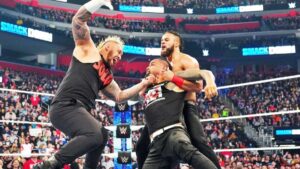The 2020 and 2021 Classes of the WWE Hall of Fame’s Legacy wing were finally revealed during the first part of the WWE Hall of Fame presentation on Tuesday night, as the WWE inducted five new names into the WWE Hall of Fame from various eras of pro wrestling history. Much like the Pro Football Hall of Fame’s Seniors Committee or the National Baseball Hall of Fame’s Golden Days Committee, the Legacy wing is posthumous inductions of pro wrestling legends from throughout pro wrestling history, from the late 1800s to the 1990s.
Here’s a quick deeper look at the names inducted into the WWE Hall of Fame Legacy Wing for the 2020 Class of the WWE Hall of Fame.
Ray “Crippler” Stevens, 2020 Class
Stevens started out in 1950 and by the age of 17, was already main-eventing with the likes of Gorgeous George, and became a 3x NWA Southern Junior Heavyweight Champion, But it was his move to the West Coast territories of the NWA that launched him into the history books of pro wrestling history. There he became a tag team specialist, capturing the NWA World Tag Team titles (San Francisco version) twice alongside Pat Patterson in The Blonde Bombers in the mid-1960s. In the early 1970s, he won the NWA World Tag Team titles twice more, with “High Chief” Peter Maivia, and by the mid-70s, headed to the AWA where he would win the AWA World Tag Team titles 3x with Nick Bockwinkel before reuniting with Patterson to win the AWA World Tag Team Championships in 1978. He would also win NWA World Tag Team titles with Greg “The Hammer” Valentine, “Superfly” Jimmy Snuka, and Ivan Koloff in the 1980s. Stevens retired from pro wrestling in 1991. He passed away in 1996 at the age of 60.
Brickhouse Brown, 2020 Class
Trained by Terry Funk and debuting in Joe Blanchard‘s Southwest Championship Wrestling in 1982, Brickhouse Brown would become a staple in the early 1980s for such NWA territories as Mid South, Mid Atlantic, and Championship Wrestling From Florida. In 1986, he worked for the WWF, where he was used as a babyface, with feuds against the likes of Hercules Hernandez, Tiger Chung Lee, and Harley Race, before departing the company in the fall. In 1987, he moved to Continental Wrestling Association (CWA), the Memphis promotion owned by Jerry Jarrett and Jerry “The King” Lawler. He would face some future legends early in their careers, such as Cactus Jack and Scott Levy (Raven), but is best remembered for his feud with Jimmy Golden. A one-time CWA Heavyweight Champion, he would remain with CWA during their brief merger with AWA and WCCW, following through with their rebranding as United States Wrestling Association (USWA), remaining with the promotion until in closed down in 1997. He would win the WCCW Texas Heavyweight Championship and AWA Southern Heavyweight Championship during the CWA’s alliance with the two companies and continued to win gold in the UWSA as Television Champion and 3x USWA Tag Team Champion. He would continue to wrestle on the independent circuit for twenty years, until he was diagnosed with prostate cancer in 2017, winning his last title, the NWA Mississippi Heavyweight title in 2004. He ultimately succumbed to his cancer in 2018 at the age of 57.
“Dr. Death” Steve Williams, 2020 Class
After playing college football and pro football (in the USFL), “Dr. Death” Steve Williams debuted with Mid-South in 1982 and by 1986, also began working in Japan with New Japan Pro Wrestling (NJPW). He was a 2x Mid-South Tag Team Champion with Ted DiBiase and captured the UWF Heavyweight Championship in 1987 (UWF was Mid-South’s rebranding to the Universal Wrestling Federation in 1986). In 1986, he began to work with Mid-Atlantic and joined WCW in 1988. By 1990, he had switched to All Japan Pro Wrestling (AJPW), where his hard-nosed physical style was best appreciated. In the late 1990s, he made several appearances for ECW back in the U.S. before a brief run in WWF in 1998 and 1999, before returning back to Japan. In 2002, he joined upstart indie promotion Major League Wrestling (MLW) for their first two years and remained with AJPW until 2004. He retired in 2009 as an All Japan Triple Crown Champion (1994), as well as countless tag team titles, including seven with Terry “Bam Bam” Gordy (5x AJPW World Tag Team titles, 2x WCW World Tag Team titles) in the Miracle Violence Connection. Williams passed away from cancer in 2009, at the age of 47, just four months after his retirement.
Baron Michele Leone, 2020 Class

From Italy, Baron Michele Leone began wrestling in Europe in 1924 before heading to the United States in 1938. When World War II broke out, Leone became a natural heel as the U.S. went to war against his native Italy. And while American-born wrestlers were heading off to join the Army, the Italian-born Leone was exempt, meaning that he was filling the holes left by departing top names. By the end of the 1940s, he was one of the countries top heels. In 1950, he won the World Heavyweight Championship in the Los Angeles territory – the title held by Jim Londos years before – and in 1952 (after a 546-day reign), lost the title to Lou Thesz when it was unified with the NWA World’s Heavyweight Championship. That unification match attracted 25,000 fans at Gilmore Field in Los Angeles (a minor league baseball stadium) and became the first wrestling card in history to break $100,000 at the gate. The following year, Leone retired from the ring, independently wealthy from his career in pro wrestling. In 1988, he was hit by a car and died from his injuries. He was 1979.
Gary Hart, 2020 Class
While he’s best remembered as one of the most influential managers in pro wrestling history, Gary Hart began his career as a wrestler in 1960. As a journeyman, he traveled multiple NWA territories, but by the late 1960s, he transitioned into manager “Playboy” Gary Hart, where he began to manager The Spoiler. In 1979, he became the head booker for World Class Championship Wrestling (WCCW), launched the Von Erichs vs The Freebirds, and managed such stars as Gino Hernandez, “Gentleman” Chris Adams, One Man Gang, Abdullah the Butcher, and others under his stable, The Stable of H. & H. Ltd. He also worked for Georgia Championship Wrestling and Mid-Atlantic in the mid-1980s, where he managed Bruiser Brody and Kevin Sullivan amongst others. When WCCW folded in 1988, Hart jumped to WCW where he launched the J-Tex Corporation, managing the likes of Terry Funk, Dick Slater, The Great Muta, and Buzz Sawyer. Hart left WCW in 1990 and briefly started his own promotion, Texas Wrestling Federation, which folded in 1991. Hart retired in 1999 but made a brief return with MLW in 2004. In 2008, Gary Hart died following a heart attack, at the age of 66.
Dick The Bruiser, 2021 Class
From the 1950s through the 1980s, Dick The Bruiser was one of the toughest heels and biggest stars in pro wrestling. Starting out in NWA territories, in 1964 he purchased the Indianapolis NWA territory and immediately withdrew from the NWA to launch the outlaw territory World Wrestling Association (WWA). Despite his own promotion now working under the NWA banner, Dick the Bruiser’s star power allowed him to continue to compete in NWA regions as well as AWA and Memphis. A 13x WWA World Heavyweight Champion, he faced WWWF World Champion “Superstar” Billy Graham in 1977 as a 48-year-old. He finally retired in 1986. Dick The Bruiser died in 1991 from internal bleeding following an esophageal hemorrhage due to weightlifting at the age of 62.
Pez Whatley, 2021 Class

Pez Whatley made his debut in 1973 in The Sheil’s Detroit territory of the NWA and continued through other NWA regions. In 1977, he did a three-month stint with NJPW in Japan and throughout the 1980s, became a star with Mid-Atlantic. When Mid-Atlantic became WCW, he headed back to Japan, this time working with AJPW. He returned to the U.S. in 1990, and worked for the WWF for two years, before heading back to WCW in 1992. He remained with WCW until 1998 when it was discovered that Whatley was suffering from heart failure. In 2005, his heart finally gave out, and he passed away at age 54. Paz Whatley was an international journeyman who became a gatekeeper of sorts in multiple major promotions around the world. A 2x NWA Florida Southern Heavyweight Champion and 3x Mid-Atlantic Tag Team Champion, Whatley faced some of the biggest names in the sport throughout his three-decade career.
Buzz Sawyer, 2021 Class
Buzz Sawyer debuted with Mid-Atlantic in 1978 and spent years building his craft, but once he arrived in Mid-South in 1983, he exploded to star in Southern wrestling, also working in Memphis and in WCCW. His full-throttle style and crazed demeanor would create blueprints for people like Jon Moxley, and in 1987, headed to NJPW for a three-year run. In 1989, he returned to the U.S. and joined WCW, where he remained until 1991. Unfortunately, he passed away following a drug overdose in 1992. He was only 32-years old.
Ethel Johnson, 2021 Class

One of the most historically important women in the history of pro wrestling, Ethel Johnson holds the distinction of being the first African-American women’s wrestler. Johnson’s two sisters – Babs Wingo and Marva Scott – also became early stars, but it was Ethel who became a superstar after her 1952 debut. One of the first wrestlers to utilize a standing dropkick in the ring, she competed until 1976. She faced Mildred Burke for the Women’s World Championship, became a pioneer for Canadian women’s wrestling after a stint with Stu Hart in Calgary, and an early star for Vince McMahon Sr.‘s pre-WWWF Capitol Sports, Johnson was a pioneer for women of all colors and ethnicities.
Paul Boesch, 2021 Class
Paul Boesch was a wrestler who debuted in 1932 and was becoming a star around the country when a car crash in 1947 forced him to retire. He turned to commentating, joining Morris Sigel‘s Houston Wrestling that same year. When Sigel passed away in 1966, Boesch bought the territory and it became one of the top outlaw promotions. Instead of working under the NWA banner, Boesch formed alliances with individual territories and featured stars from Mid-South, WWF, and WCCW. When most of his allies turned to Mid-Atlantic in the 1980s, Boesch closed down Houston Wrestling in 1987 and instead joined WWF. Two years later, he died of a heart attack at age 76.
These names join these names in the WWE Hall of Fame Legacy Classes that began with the 2016 WWE Hall of Fame:
- 2016 Legacy Class: Mildred Burke, Frank Gotch, George Hackenschmidt, Ed “Strangler” Lewis, Pat O’Connor, Lou Thesz, “Sailor” Art Thomas
- 2017 Legacy Class: Martin “Farmer” Burns, June Byers, Haystacks Calhoun, Judy Grable, Dr. Jerry Graham, Luther Lindsay, Joseph “Toots” Mondt, Rikidozan, Bearcat Wright
- 2018 Legacy Class: Stan Stasiak, Lord Alfred Hayes, Dara Singh, Cora Combs, El Santo, Jim Londos, Rufus R. Jones, Sputnik Monroe, Boris Malenko, Hiro Matsuda
- 2019 Legacy Class: Bruiser Brody, Wahoo McDaniel, Luna Vachon, Special Delivery “S.D.” Jones, Professor Toru Tanaka, Primo Carnera, Joseph Cohen, Hisashi Shinma, “Playboy” Buddy Rose, Jim Barnett
Stay tuned to the Last Word on Pro Wrestling for more on this and other stories from around the world of wrestling, as they develop. You can always count on LWOPW to be on top of the major news in the wrestling world, as well as to provide you with analysis, previews, videos, interviews, and editorials on the wrestling world. WWE fan? You can check out an almost unlimited array of WWE content on the WWE Network and Peacock.
Looking to talk wrestling, pro football, or any number of sports? Head on over to the LWOS Boards to engage in conversation with fellow fans!













